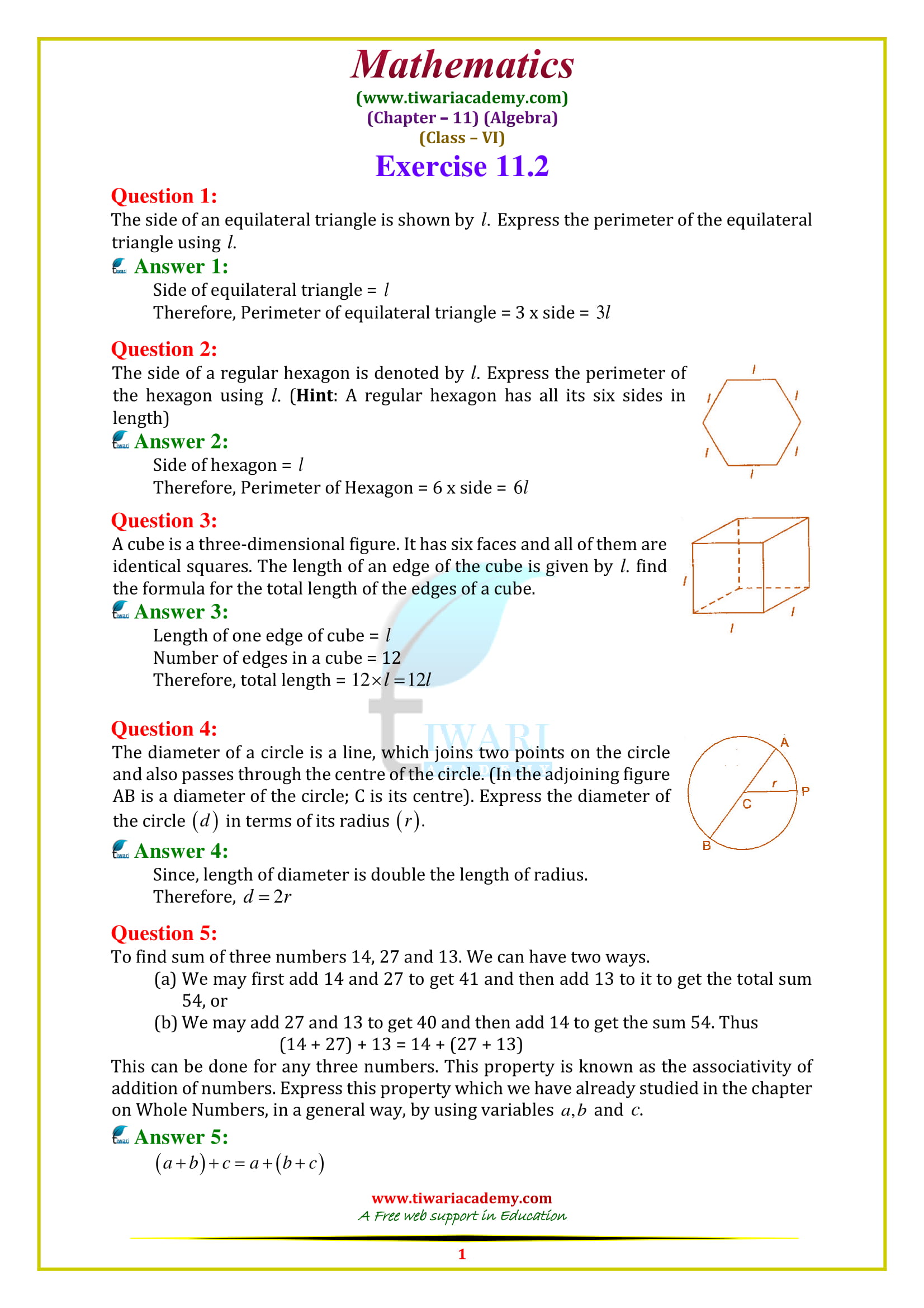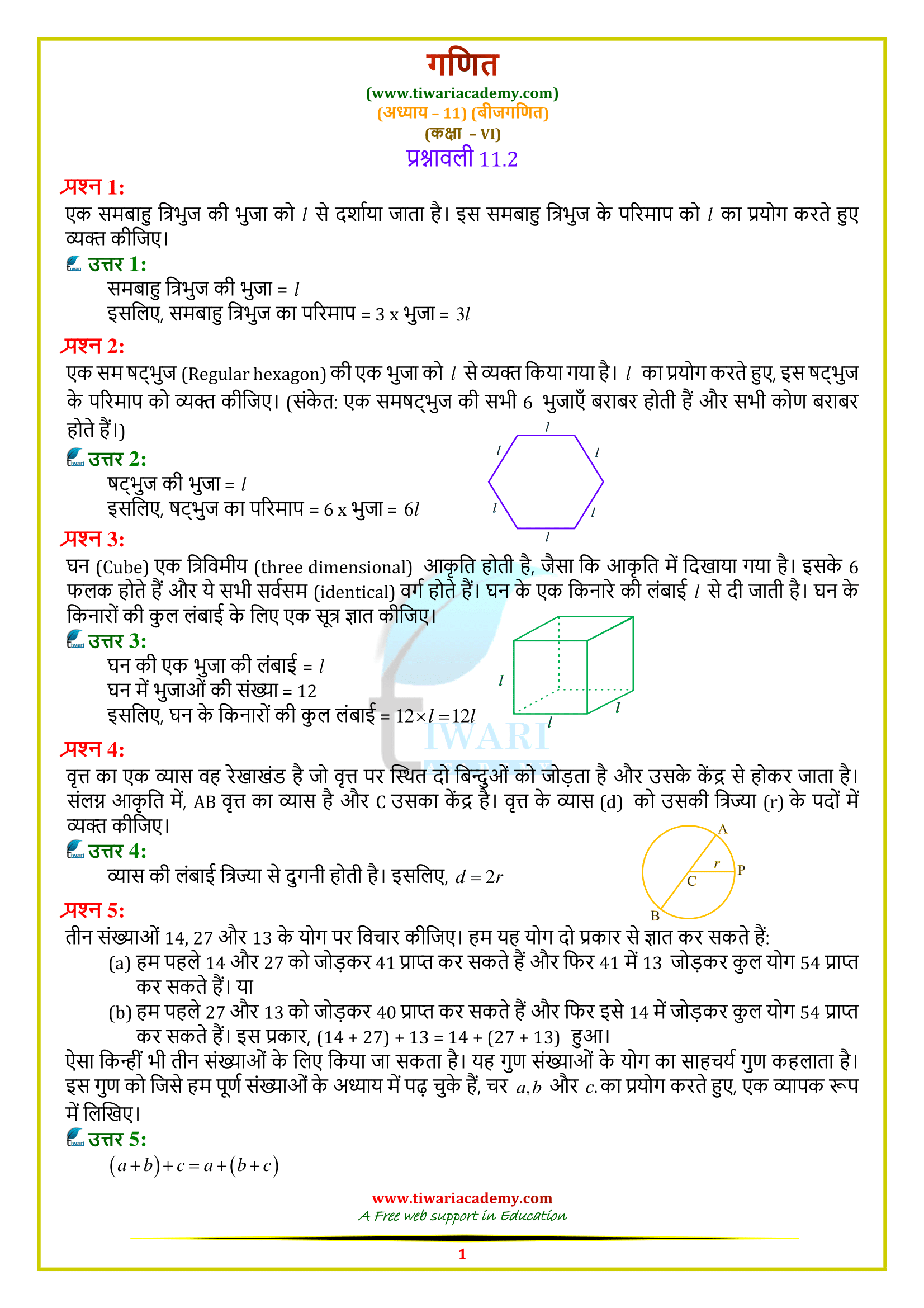NCERT Solutions for Class 6 Maths Chapter 11 Exercise 11.2 Algebra in Hindi and English Medium prepared for CBSE and State Boards. Explore updated, bilingual NCERT solutions for Class 6 Maths, Chapter 11 Exercise 11.2 on Algebra at Tiwari Academy, crafted for CBSE and State Board students’ success.
6th Maths Exercise 11.2 Solutions in Hindi and English Medium
Class 6 Maths Chapter 11 Exercise 11.2 Solution
Class VI Maths NCERT Book Ex. 11.2 solution chapter 11 Algebra in PDF file format free to download available in Hindi and English Medium. All the contents are updated as per new session for CBSE and State board students. In NCERT Solutions of class 6 math exercise 11.2 the questions are based on the concept of perimeter of 2-D figures in mensuration. All the questions are easy to solve and interesting to learn.
Basic Operations on Literal Numbers
Since the literal numbers are used to represent numbers, they obey all the rules (including those of signs) regarding the operations of addition, subtraction, multiplication and division of numbers. For the same reason, literals satisfy all rules as well as properties of these operations.
| Class: 6 | Mathematics |
| Chapter: 11 | Exercise: 11.2 |
| Chapter Name: | Algebra |
| Content: | PDF and Video Solutions |
| Medium: | Hindi and English Language |
Class 6 Maths Chapter 11 Exercise 11.2 Solution in Videos
Addition and Subtraction Operations of Literal Numbers
We shall indicate addition, by placing a plus (+) sign between the two quantities to be added. Likewise, subtraction will be indicated by placing a minus (–) sign between the two quantities when the second is to be subtracted from the first.
Class 6 Maths Exercise 11.2 Important Questions
What are the four rules of algebra?
The Basic Laws of Algebra are the associative, commutative and distributive laws. They help explain the relationship between number operations and lend towards simplifying equations or solving them. The arrangement of addends does not affect the sum.
Write each of the following phrases using numbers, literals and the basic operation of addition: (i) The sum of x and 4 (ii) y added to 7 (iii) 6 more than a number x (iv) y added to the sum of x and 3.
(i) x + 4
(ii) y + 7
(iii) x + 6
(iv) (x + 3) + y
What do the letters mean in algebra?
In algebraic expressions, letters represent variables. These letters are actually numbers in disguise. In this expression, the variables are x and y. We call these letters “variables” because the numbers they represent can vary—that is, we can substitute one or more numbers for the letters in the expression.
What are literal numbers?
Literal numbers are the letters which are used to represent a number. The literal numbers are also known as literals. Literal numbers obey all the rules of addition, subtraction, multiplication and division of numbers. Thus, a + b means b is added to a.
What are the 4 basic operations?
The four operations are addition, subtraction, multiplication and division.
We can perform the required addition or subtraction, in numerical expressions. But in algebraic expressions which include letters, we can only indicate these operations, because we do not know the numbers these letters represent. For example, we can add 5 and 9, but we cannot add x and 3 because we do not know the number that x represents. In the latter case, we can only indicate the addition by writing x + 3. Likewise, we cannot subtract y from x, but we can indicate the subtraction by writing x – y.
Is exercise 11.2 of 6th standard NCERT Maths simple?
Exercise 11.2 of 6th standard Maths is not very simple. But if we compare exercise 11.2 of class 6th Maths with exercise 11.1 of class 6th Maths then we will find exercise 11.2 of class 6th Maths easy.
Which questions of exercise 11.2 of 6th standard Maths have a chance to come in the unit test?
Exercise 11.2 of 6th standard Maths has 5 questions and no examples. Out of these 5 questions, questions 2, 3, and 5 of exercise 11.2 of class 6th Maths have a chance to come in the unit test.
How much time, students need to prepare exercise 11.2 of 6th Maths for the exams?
Students need a maximum of 1-2 days to prepare exercise 11.2 of class 6th Maths if they give 1-2 hours per day to this exercise. This time is an approximate time and not fixed. This time can vary because no students can have the same ability, efficiency, working speed, etc.
Which questions of exercise 11.2 of class 6 Maths are the best questions?
Exercise 11.2 of class 6th Maths has 5 questions in all. Questions 3 and 5 of this exercise are the best questions. These questions are nice and interesting. In question 3, the length of an edge of the cube is given by l and students have to find the find the formula for the total length of the edges of a cube. Question 5 is related to associative (addition) property.






